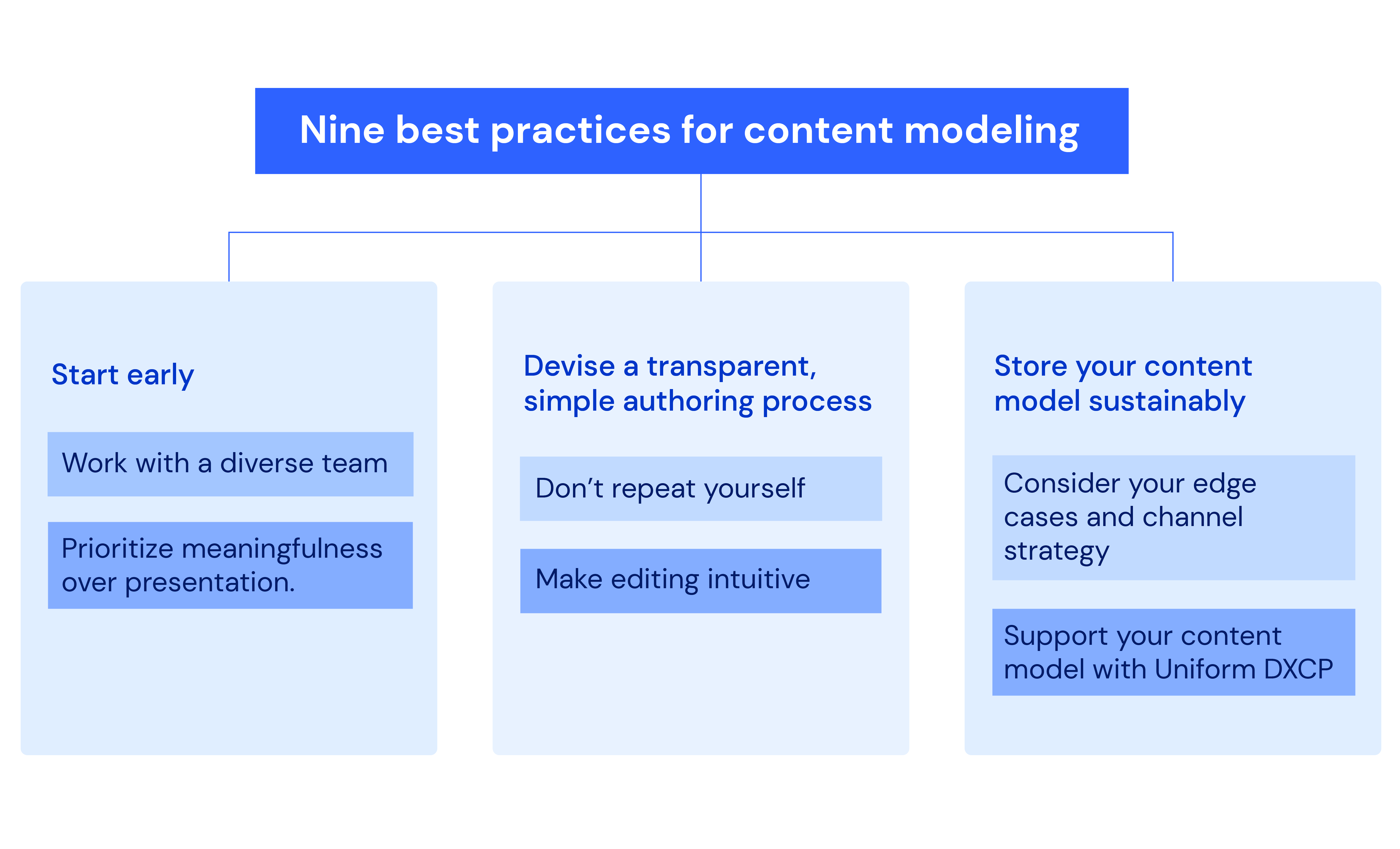Creating an effective content model might feel overwhelming on day one, but it’s actually not daunting at all. Uniform is here to help, starting with nine best practices for content modeling, as explained below. Embrace them for a smooth sail of the modeling process for your team, get buy-in from stakeholders, and build a compelling content strategy.
The right time to start constructing a content model is yesterday, but no worries if your team still hasn’t done that yet. Whenever you launch a channel or migrate CMS providers, or before you create content types for your website, you can develop or refine your content model right then.
Another appropriate time to begin the building process is while you’re creating or redesigning your website. Essentially, there’s never a bad time to build a content model, but the earlier you start, the better off you’ll be, thanks to its many remarkable benefits. The most significant ones are as follows:
- A more efficient content strategy. Content models foster the creation of a holistic, coherent content strategy. By leveraging the proper model, creators can pull assets from a central bank of material and draft new content pieces whenever necessary.
- More informed insights. Adopting an organized content-model template systematizes your content. With that new, more orderly perspective, your team would notice relationships that slipped through the cracks before. Also open is a window for revamping outdated content or unearthing deep problems within your CMS.
- Unanimous buy-in or consensus. An effective content model built with the best practices becomes a single source of truth (SSoT) for your organization. All stakeholders are then on the same page as to what the content is, whom it touches, how it adds value, and what workflows are necessary for its production. More investment in your overall content strategy often follows.
- Less content debt. Content debt is material that’s poorly organized or that doesn’t meet the needs of your target audience, such as content that’s out-of-date or that doesn’t match your brand’s tone, voice, or messaging. Content models eliminate content debt by opening up opportunities for content reuse and recycling, which leads to a more sustainable, ROI-boosting strategy.
Outstanding content models incorporate input from cross-team members. However, often siloed is the development or writing team. Those folks then work in a “bubble” without being able to contribute to the process, which needs consensus and collaboration among key stakeholders in key departments.
Who are those stakeholders, you wonder? As a best practice in
content modeling, you should solicit input from people in the following roles:
UX designers
Content modeling and UX design go hand in hand. UX designers are experts at how the input on your website’s back end affects the output on the front end. They can also suggest important website features, such as accessibility to a broader audience and more user-friendly capabilities.
Developers
With their knowledge of how website components fit together to function properly and adeptness with your content’s technical structure, developers can guide your team vis-à-vis content fields and frameworks. Accordingly, avoid locking your content into a structure too early in the process. Instead, make modeling a theoretical activity at first. Once you’re sure that a particular structure would fulfill your content needs, give the dev team the green light to proceed.
Content authors
Due to their important role in producing, editing, and even uploading content to your CMS, your writers are the most connected to your content. In case of issues with CMS workflows or other processes, they are your first line of defense. Since a primary function of your content model is to alleviate such issues, the writing team—or a representative from it—should participate in the process.
Domain experts
Also called subject-matter experts (SMEs), domain experts support content strategy with in-depth knowledge of industry trends and concepts. Those professionals become instrumental if you choose to build
content pillars, which require a deeper understanding of several technical concepts under a singular topic umbrella.
Marketers
Marketing’s involvement in the process should be twofold:
- Marketers should research your target audience. Customer personas with both demographic and psychographic information on your ideal user are helpful tools for reinforcing your content model.
- Marketers can beef up your content by strategically applying SEO best practices like schema markups and meta descriptions.
System integrators
These are your developers, administrators, DB designers and other teams who, being familiar with the other systems in your organization, would speak up if you are about to duplicate in your model content that already exists in those internal mechanisms.
Content teams often obsess over content display. As important as usability and layout are, they shouldn’t be your primary concern. The readability and meaningfulness of your content and the degree of its helpfulness to the audience must take precedence.
Therefore, focus on content types and content attributes. Determine how they can work together toward a more sustainable, efficient model of content production for your team. Additionally, standardize their nomenclature or naming conventions. Templatize areas of the process that are a fit for a standard format, and remember that the SSoT concept is your end goal.
If you put meaningfulness and sustainability first, your content will fall into place naturally.
Part of what makes best practices in content modeling effective is a lucid and straightforward cross-team collaboration experience. Stakeholders should have a vested interest in key cross-team workflows, one of which is the authoring experience.
As mentioned, writers have the most direct connection to content. Ensure that your content team is familiar with writers’ workflows and that they all brainstorm together on how to tackle areas that need optimization or improvement.
Does the drafting process start with a Google Doc? When should you move the content to a domain-specific system? Teams should discuss and agree on the answers to those questions so that content can move through its lifecycle as seamlessly as possible.
UI designers should also work closely with writers, who can make UX-related recommendations as they research the Search Engine Results Page (SERP) to outline and ideate content material. Similarly, the UX team can offer formatting suggestions to optimize content readability and usability.
Since redundancy is the enemy of content models, every attribute must reflect something unique.
- Subject models, which are useful for content types with unreusable material, such as sales pages or landing pages.
- Specification models, which are useful for content your team recycles across pages or platforms, such as author pages or SEO metadata.
Leveraging a unique model framework for both reusable and unreusable data types enhances your team’s content-management result. By thinking of content as “data,” teams can produce more sustainable content that doesn’t rely on context and that serves a good purpose in multiple situations. That mindset also ensures accuracy in content updates: Again, think “data.”
As your content library grows, the content model can become complex. For a continually smooth and intuitive editing and production process, organization and structure are essential.
To that end, group content types into reusable and single-use content for faster editing. Better yet, have your team label content attributes—fields like SEO meta descriptions, author pages, use cases, and CTAs—so that they’re easily searchable and editable.
Save your model sustainably or flexibly in three document formats:
- Data schema
- Spreadsheet
- Diagram
Below are the formats’ pros and cons.
Document Type | Pros | Cons |
|---|
Data schema | 1. Helps developers spot technical issues early on. 2. Is an integral component that supports content-technology stacks. | 1. Tends to be tactic focused. 2. Might be difficult for nontechnical stakeholders to understand. |
Spreadsheet | 1. Offers an in-depth display of the content structure. 2. Serves as a comprehensive list of all content types and attributes. | 1. Can focus more on tactics, much like data schema. 2. Might be difficult for nontechnical stakeholders to understand, much like data schema. |
Diagram | 1. Clearly presents the content model through visual elements. 2. Is transparent to both technical and nontechnical teams. | 1. Displays only high-level concepts. Lacks the necessary features for building content models. 2. Deals primarily in concepts, which might be difficult for team members to grasp. |
Most content teams employ all three formats to maximize flexibility. Regardless of which format you apply, ensure that all stakeholders know where those CMS documents reside, i.e., inform everyone of the content model’s location and grant the proper access permissions. Your content model can then fulfill one of its primary functions as an SSoT.
A common complaint about structured content is that you must build a model to accommodate all your content, including material that’s not slated to be shared. Avoid “overfit,” which results if you create too many models to accommodate all the examples. Instead, limit content models to the reusable and repeatable elements only. Similarly, exclude elements that pertain to content presentation in a channel.
The above two issues are where a digital experience composition platform such as Uniform can help. How? By enabling reuse with tasks and governance that are aligned with how content is actually being deployed in a channel.
Building a content model that adheres to the eight best practices described above can be a formidable task. Notwithstanding that the process is inherently collaborative, even the most capable teams need support. Well worth consideration is a
digital experience composition platform (DXCP) like Uniform.
With Uniform, creators can work with multiple sources of structured content to build their own and reuse it flexibly. You get the advantages of structured content without the common limitations.
For details on
the benefits of Uniform that promote content efficiency and sustainability,
schedule a demo with us.








.jpg&w=1080&q=90)
.jpg&w=1080&q=90)